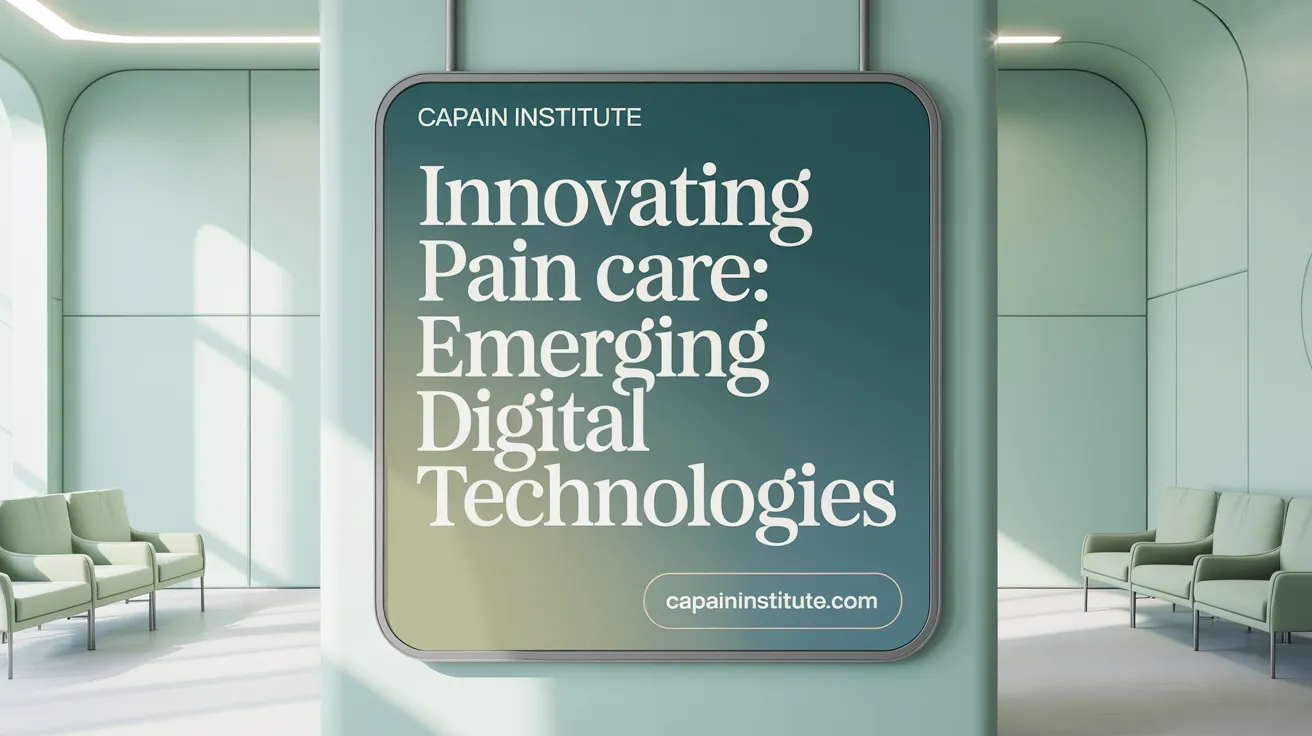Understanding Chronic Pain and the Need for New Management Strategies
Definition and Impact of Chronic Pain
Chronic pain is defined as pain persisting for more than three months, often continuing beyond the expected period of healing. It affects about 20% of adults in the U.S., limiting daily activities for many, and contributes to emotional challenges like depression, anxiety, and sleep disturbances. This condition can affect any part of the body, from joints to nerves, and dramatically lowers quality of life.
Challenges in Treating Chronic Pain
Treating chronic pain is complex due to its diverse causes, including tissue damage, nerve injury, and altered brain processing. Patients often experience overlapping types of pain—nociceptive, neuropathic, and nociplastic—which complicates diagnosis and treatment. Traditional assessment methods may not fully capture a patient’s pain experience, requiring more comprehensive evaluation.
Limitations of Opioid-Based Treatments
Historically, opioids were widely used to manage chronic pain but are now recognized for their risk of addiction, tolerance, and side effects. The opioid crisis has prompted a shift toward limiting opioid prescriptions, emphasizing safer alternatives. Reliance on opioids often leads to diminished effectiveness and potential worsening of pain.
Importance of Multi-Modal and Personalized Approaches
Effective chronic pain management increasingly focuses on multi-modal strategies combining physical therapy, psychological support, behavioral therapies, and minimally invasive interventions. Personalized care tailors treatment to individual patient profiles and pain mechanisms, improving outcomes and reducing dependence on medications. Advances such as nerve ablation, neuromodulation, and emerging technologies like virtual reality support this shift toward comprehensive, patient-centered care.
Minimally Invasive Interventional Techniques Revolutionizing Pain Relief

What are some minimally invasive interventional techniques currently used for chronic pain management?
Several advanced minimally invasive pain interventions are transforming chronic pain treatment, offering alternatives especially for patients ineligible for surgery. Genicular nerve radiofrequency ablation (RFA) specifically targets nerves around the knee to disrupt pain signals, providing relief that can last from six to 24 months for chronic knee pain and osteoarthritis.
The basivertebral nerve ablation, known as the Intracept procedure for back pain, is tailored for vertebrogenic back pain caused by damage to the vertebral endplates. This technique uses radiofrequency energy to heat and treat the basivertebral nerve, alleviating pain associated with sitting, bending, or lifting.
Spinal cord stimulation therapy involves implanting a device that emits electrical pulses to interfere with pain signal transmission in the spinal cord, thereby reducing the sensation of pain for various chronic conditions.
Minimally invasive lumbar decompression (MILD) procedure for lumbar stenosis is an outpatient procedure targeting lumbar stenosis by removing ligamentous tissue that narrows the spinal canal. This creates more space within the spine to relieve leg and back pain.
How do these techniques help reduce reliance on opioids?
By directly targeting sources of pain through precise interventions, these minimally invasive chronic pain treatments offer safe, effective, and often long-lasting relief. Patients experience improved pain control without the need for escalating doses of opioid medications, which carry significant risks and side effects.
These procedures enhance patients' quality of life by diminishing pain intensity and functional limitations. Consequently, providers can focus on nonpharmacologic pain management strategies, minimizing dependency on opioids and promoting better overall health outcomes.
Overall, these innovative interventions represent a paradigm shift in chronic pain treatment, especially relevant in medical centers such as UCLA Health pain management and specialized clinics around Los Angeles, where expertise in these techniques continues to evolve and expand.
Emerging Technologies: Virtual Reality, AI, and Wearables in Pain Management

What emerging digital technologies are being integrated into chronic pain care?
Emerging digital technologies are transforming chronic pain management through innovative, non-invasive, and personalized approaches. Virtual reality (VR) has become a powerful tool for chronic pain treatment by providing distraction, neural reprocessing, and mindfulness training. VR's ability to promote brain neuroplasticity helps retrain neural pathways related to pain perception, offering analgesic effects comparable to opioid medications but without their side effects. This makes VR accessible for home use and an important complement to conventional therapies.
Augmented reality (AR) enhances telehealth by enabling real-time, interactive remote treatments. AR supports patients who have mobility constraints or live far from specialist clinics, enabling remote guidance and monitoring that improve access to care.
Wearable medical devices play a crucial role by continuously monitoring physiological signals such as vital signs and movement patterns. These devices provide clinicians with valuable data for adjusting treatments and tracking patient progress, helping reduce depressive symptoms and reliance on opioid medications.
Artificial intelligence (AI) elevates chronic pain care by analyzing complex datasets to predict patient responses and optimize treatment plans. AI-driven neuromodulation devices can adapt stimulation dynamically based on patient activity and positioning, offering tailored pain relief. Additionally, AI supports integration with VR and wearable tech for a comprehensive, personalized approach to pain management.
Together, these emerging technologies offer promising avenues to improve quality of life for chronic pain patients and reduce opioid dependence through more precise, accessible, and effective therapies.
Innovations in Pharmacologic and Regenerative Treatments for Chronic Pain

What are the recent pharmacologic innovations for chronic pain management?
Recent pharmacologic advances have introduced promising new medications targeting specific pain pathways. Notably, the FDA approved Journavx (suzetrigine) in January 2025, the first novel class of pain medication in over 20 years. Journavx specifically targets Nav1.8 sodium channels, which play a critical role in transmitting pain signals in sensory nerves. By selectively blocking these channels, suzetrigine effectively reduces chronic pain without affecting other nerve functions.
In addition, researchers at Stanford and Washington University developed a new generation of cannabinoid compounds, such as VIP36, that target peripheral CB1 receptors. Unlike traditional cannabinoids, these compounds provide pain relief without psychoactive side effects. This precise targeting minimizes adverse effects and offers a safer analgesic alternative, opening potential new pathways for chronic pain management.
How is regenerative medicine advancing pain treatment?
Regenerative medicine techniques, including platelet-rich plasma (PRP) injections and bone marrow concentrate injections, are gaining traction as effective treatments for chronic pain. These regenerative injections utilize the patient's own healing factors to stimulate tissue repair, reduce inflammation, and promote recovery in damaged muscles, joints, and connective tissues.
The autologous nature of PRP and bone marrow concentrates provides a favorable safety profile, minimizing risks compared to traditional pharmacologic treatments or surgery. Ultrasound or fluoroscopic guidance enhances precision, allowing targeted delivery to affected areas. These biologic therapies serve as valuable adjuncts or alternatives to conventional therapies, aiming to restore function and alleviate pain at its source.
Advancements in nerve ablation techniques
New nerve ablation methods, such as cooled-tip radiofrequency and pulsed radiofrequency, offer precise, minimally invasive options to disrupt pain signals in targeted nerves. These advanced techniques provide improved accuracy and prolonged pain relief for conditions like chronic low back pain and neuropathic disorders.
By selectively damaging problematic nerves, these procedures can effectively reduce pain transmission without affecting surrounding tissues. Combined with regenerative and pharmacologic approaches, advanced nerve ablation expands the therapeutic arsenal for personalized chronic pain management.
Behavioral and Brain-Based Therapies: Reprocessing Pain and Neurofeedback

What non-pharmacological behavioral therapies are emerging in chronic pain care?
Behavioral and brain-based therapies are gaining prominence as effective, non-pharmacological pain treatments options for managing chronic pain. Pain reprocessing therapy is an innovative behavioral approach that aims to alter how the brain interprets pain signals. Rather than focusing on the physical source of pain alone, this therapy helps patients reframe their perception of pain, which can significantly reduce its intensity and impact on daily life.
In addition to behavioral strategies, advanced technologies are being used to retrain the brain's pain networks. EEG neurofeedback employs real-time brainwave monitoring to help patients learn to regulate pain-related neural activity. Similarly, virtual reality (VR) systems offer immersive experiences designed to reorganize the nervous system’s response to pain by providing distraction, neural reprocessing, and mindfulness training. These methods have demonstrated substantial and lasting pain relief in pilot studies.
Importantly, these therapies improve patients’ quality of life without the need for drug reliance, addressing psychological factors linked to chronic pain such as anxiety, depression, and sleep difficulties. Through combining behavioral interventions with emerging neurotechnology, chronic pain care increasingly emphasizes whole-person health and sustainable management strategies.
Comprehensive and Personalized Pain Management Approaches in Los Angeles

How are multidisciplinary programs enhancing chronic pain treatment?
Multidisciplinary chronic pain programs in Los Angeles adopt an integrated approach that blends physical therapy, nutrition, psychological interventions, and lifestyle modifications. This comprehensive strategy addresses the complex and multifactorial nature of chronic pain by tackling not only the physical symptoms but also the emotional and behavioral components, such as depression and stress. Programs often incorporate Pain reprocessing therapy, cognitive-behavioral therapy, mindfulness practices, and tailored exercise plans to improve coping mechanisms and physical endurance.
What is the importance of personalized approaches in pain management?
Personalized pain management is becoming increasingly crucial, particularly as it minimizes the trial-and-error process common in earlier treatment paradigms. By evaluating the specific pain mechanisms involved — whether nociceptive, neuropathic, or nociplastic — clinicians can develop individualized treatment plans that target pain generators or relevant brain alterations. This customization improves pain control, reduces unnecessary interventions, and enhances quality of life. Techniques such as nerve ablation, neuromodulation, including AI-driven neuromodulation devices, and advanced pharmacologic treatments can be selectively applied based on patient-specific diagnostic findings.
Role of interdisciplinary clinics and rehabilitation programs
Specialized clinics like the California Pain Medicine Center and UCLA Health offer interdisciplinary, residential rehabilitation programs. Here, board-certified pain specialists, psychologists, physical therapists, and other professionals collaborate to deliver comprehensive care. These programs emphasize patient education, independence in pain management, and incorporate cutting-edge treatments including ketamine infusions, spinal cord stimulation, and regenerative therapies.
Integration of physical therapy, psychological support, lifestyle modifications
Successful chronic pain management integrates physical therapies to restore function, psychological support to manage emotional impacts, and lifestyle changes such as nutrition and exercise to promote overall well-being. Such holistic care acknowledges the interconnection between physical and mental health, fostering sustainable improvements.
Educational focus for new pain physicians on innovative treatments
Emerging modalities like virtual reality, AI-driven neuromodulation devices, and novel pharmacotherapies are reshaping chronic pain treatment. Training future pain physicians in these innovations ensures they can offer comprehensive, state-of-the-art care that reduces opioid reliance and optimizes patient outcomes. Emphasizing education on these advancements prepares providers to better meet the diverse needs of chronic pain patients in regions like Los Angeles.
Challenges and Advances in Chronic Pain Neuroscience and Assessment
What recent neuroscience findings are influencing chronic pain management?
Recent advances in neuroimaging technologies have deepened our understanding of chronic pain by revealing abnormal brain activity patterns and altered concentrations of brain metabolites in areas such as the anterior cingulate cortex and dorsolateral prefrontal cortex. These findings illuminate how chronic pain persists due to changes in neural circuits, supporting the development of targeted treatments to modulate brain function and alleviate pain. For more details, see the article on Advances in chronic pain treatment and neurobiology.
How are assessment methods evolving for better pain management?
Traditional pain assessment using numerical rating scales is limited as it does not fully capture the complexity of pain's impact on daily life. Emerging tools now evaluate the relationship between pain and movement through biobehavioral perspectives, such as the BioPMovQ instrument, allowing for more precise and personalized treatment strategies.
Moreover, recognition of psychological factors—especially placebo and nocebo effects—is influencing treatment outcomes in chronic pain care. These effects underscore the importance of managing patient expectations to optimize interventions. Learn more about Placebo and nocebo effects in pain treatment.
Genetic studies employing Mendelian randomization techniques have identified modifiable risk factors, such as those for knee osteoarthritis, offering avenues for preventive measures and personalized therapy plans. This is detailed in research on Genetic risk factors and Mendelian randomization in pain research.
These advances collectively foster a more nuanced, individualized approach to chronic pain management, enhancing both diagnosis and therapeutic efficacy.
The Future Landscape of Chronic Pain Management
Ongoing Research in Gene Therapy and Biomarkers
Cutting-edge research is focusing on gene therapy and biomarker identification to personalize chronic pain treatment. These advances aim to tailor therapies to individual biological profiles, potentially improving effectiveness and minimizing side effects.
Potential of Psychedelics for Refractory Pain Conditions
Psychedelic compounds such as psilocybin and LSD are being investigated for their promising role in managing difficult-to-treat pain, including neuropathic pain and fibromyalgia. Early studies suggest these substances can modulate brain networks, offering new avenues beyond traditional therapies.
Need for Continuous Education of Clinicians
As new pain management technologies evolve rapidly, ongoing education for clinicians is vital. Familiarity with emerging treatments like virtual reality, AI-driven neuromodulation, and novel pharmacologic agents ensures informed, comprehensive care.
Shift Toward Safer, Personalized, and Multi-Modal Care
The management of chronic pain is increasingly moving away from opioid dependence to integrative approaches combining behavioral therapies, regenerative medicine, and precision-targeted interventions. Emphasizing safety and personalization enhances patient outcomes and quality of life.
